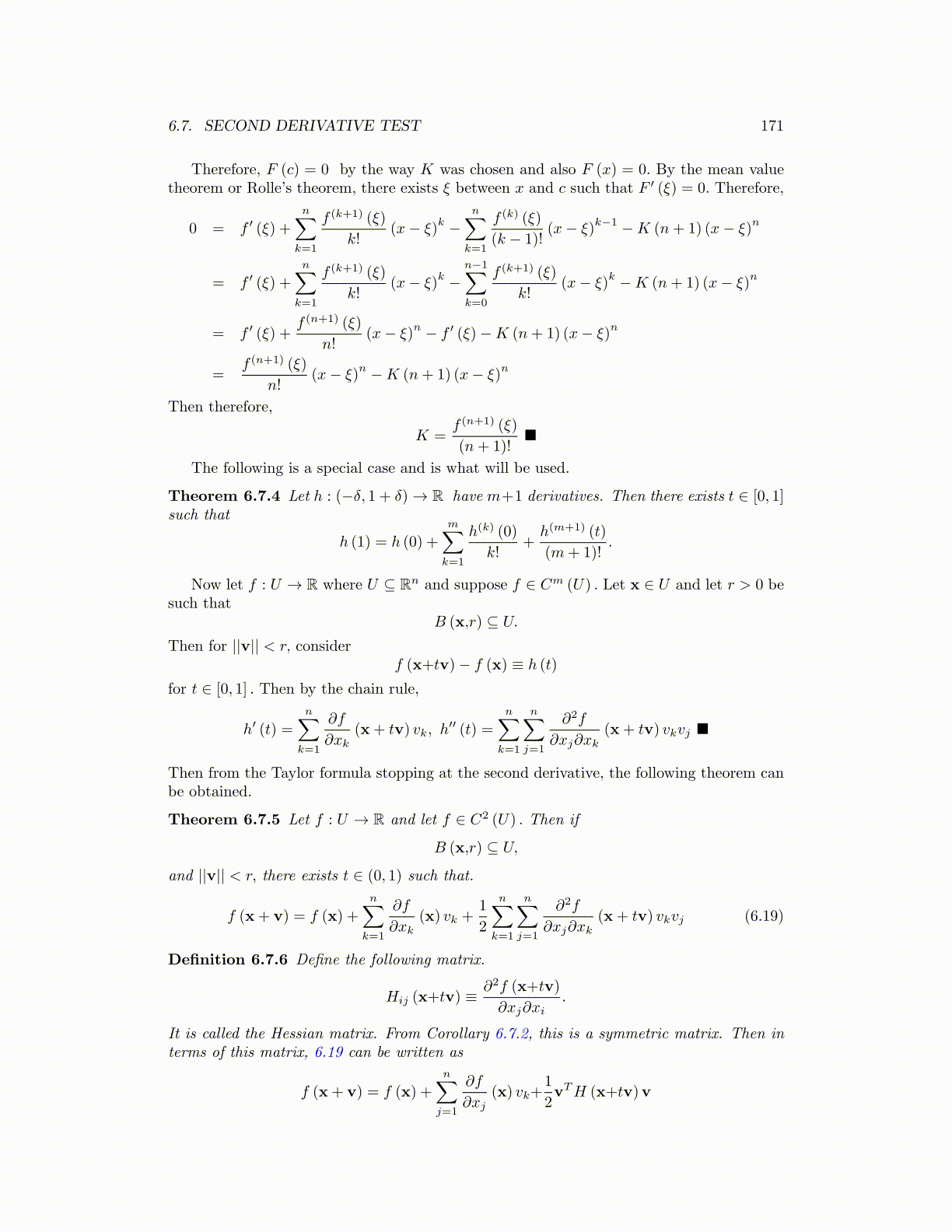
6.7. SECOND DERIVATIVE TEST 171
Therefore, F (c) = 0 by the way K was chosen and also F (x) = 0. By the mean valuetheorem or Rolle’s theorem, there exists ξ between x and c such that F ′ (ξ) = 0. Therefore,
0 = f ′ (ξ) +
n∑k=1
f (k+1) (ξ)
k!(x− ξ)
k −n∑
k=1
f (k) (ξ)
(k − 1)!(x− ξ)
k−1 −K (n+ 1) (x− ξ)n
= f ′ (ξ) +
n∑k=1
f (k+1) (ξ)
k!(x− ξ)
k −n−1∑k=0
f (k+1) (ξ)
k!(x− ξ)
k −K (n+ 1) (x− ξ)n
= f ′ (ξ) +f (n+1) (ξ)
n!(x− ξ)
n − f ′ (ξ)−K (n+ 1) (x− ξ)n
=f (n+1) (ξ)
n!(x− ξ)
n −K (n+ 1) (x− ξ)n
Then therefore,
K =f (n+1) (ξ)
(n+ 1)!■
The following is a special case and is what will be used.
Theorem 6.7.4 Let h : (−δ, 1 + δ) → R have m+1 derivatives. Then there exists t ∈ [0, 1]such that
h (1) = h (0) +
m∑k=1
h(k) (0)
k!+h(m+1) (t)
(m+ 1)!.
Now let f : U → R where U ⊆ Rn and suppose f ∈ Cm (U) . Let x ∈ U and let r > 0 besuch that
B (x,r) ⊆ U.
Then for ||v|| < r, considerf (x+tv)− f (x) ≡ h (t)
for t ∈ [0, 1] . Then by the chain rule,
h′ (t) =
n∑k=1
∂f
∂xk(x+ tv) vk, h
′′ (t) =
n∑k=1
n∑j=1
∂2f
∂xj∂xk(x+ tv) vkvj ■
Then from the Taylor formula stopping at the second derivative, the following theorem canbe obtained.
Theorem 6.7.5 Let f : U → R and let f ∈ C2 (U) . Then if
B (x,r) ⊆ U,
and ||v|| < r, there exists t ∈ (0, 1) such that.
f (x+ v) = f (x) +
n∑k=1
∂f
∂xk(x) vk +
1
2
n∑k=1
n∑j=1
∂2f
∂xj∂xk(x+ tv) vkvj (6.19)
Definition 6.7.6 Define the following matrix.
Hij (x+tv) ≡∂2f (x+tv)
∂xj∂xi.
It is called the Hessian matrix. From Corollary 6.7.2, this is a symmetric matrix. Then interms of this matrix, 6.19 can be written as
f (x+ v) = f (x) +
n∑j=1
∂f
∂xj(x) vk+
1
2vTH (x+tv)v